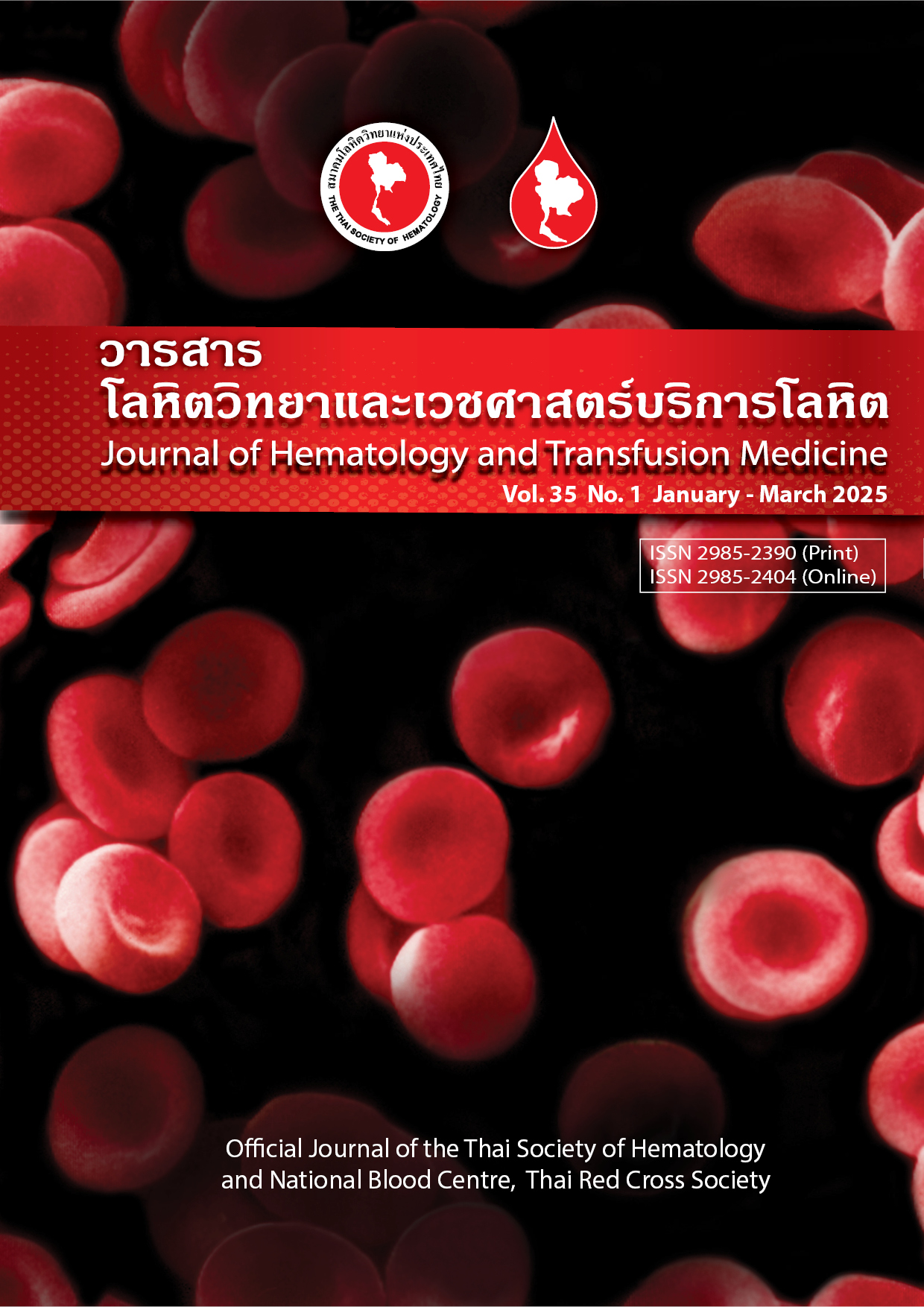Use of intraoperative and postoperative blood transfusions on patients undergoing cardiac surgery at the Central Chest Institute of Thailand: a single-center retrospective analysis
Keywords:
Cardiac surgery, Blood supply, Blood transfusion, Patient blood management, การผ่าตัดหัวใจ, การจัดหาเลือด, การให้เลือด, การบริหารจัดการเลือดให้ผู้ป่วยAbstract
Abstract:
Introduction: Cardiac surgery requires more blood components than most other medical disciplines. The Central Chest Institute of Thailand (CCIT), an institution of medicine committed to developing this particular field, decided to implement a patient blood management (PBM) program to substantially improve blood use. Objective: This study aimed to evaluate intraoperative and postoperative blood transfusions among patients undergoing cardiac surgery comprehensively analyzed the consumption of blood components in all medical departments of the CCIT. Materials and Methods: The use of blood components at the CCIT was thoroughly examined retrospectively over two years. Based on a medical reporting system of all medical disciplines, all transfused patients in cardiac surgery and their blood components were identified using their characteristics, including sex, age, ABO blood group, antibody screening and identification, medical operations, and operation-related groups during intraoperative and postoperative periods. Results: This retrospective single center study included all inpatients who underwent cardiac surgery from 2023-2024, corresponding to more than 95% (1,722 cases) of all CCIT in-patients. We found that the need for blood supply remained generally consistent, with packed red cells, frozen plasma and single donor plateletpheresis units having administered to >95%, 90%, and 45% of all cardiac surgery patients, respectively. Most blood component units were applied during Bentall's procedure to repair the aneurysm. Remarkedly, the first detection of an anti-Mia antibody occurred during postoperative hospitalization after an intraoperative 24-unit red cell transfusion. Conclusion: Our analysis suggests each blood component's consumption could be related to clinical performance groups; thus, the PBM should be set up hospital-internally to enhance bloodless surgical procedures, increase preoperative anemia management and identify the causes of unnecessary blood transfusions.
บทคัดย่อ
บทนำ การผ่าตัดหัวใจต้องการใช้ส่วนประกอบของเลือดมากกว่าการผ่าตัดชนิดอื่น สถาบันโรคทรวงอก เป็นสถาบันการแพทย์ที่มุ่งมั่นพัฒนาสาขานี้โดยเฉพาะ จึงได้ดำเนินโครงการ patient blood management (PBM) เพื่อใช้ปรับปรุงการใช้เลือดให้เหมาะสม วัตถุประสงค์ การศึกษาย้อนหลังนี้มีวัตถุประสงค์เพื่อประเมินการให้เลือดผู้ป่วยที่ได้รับการผ่าตัดหัวใจระหว่างและหลังการผ่าตัด โดยวิเคราะห์ข้อมูลการใช้ส่วนประกอบของเลือดของผู้ป่วยในทุกคลินิกของสถาบันฯ วัสดุและวิธีการ วิเคราะห์ข้อมูลการใช้เลือดของผู้ป่วยที่ได้รับการรักษา ย้อนหลังในช่วงเวลา 2 ปี จากระบบฐานข้อมูลของสถาบันฯ โดยเก็บข้อมูลผู้ป่วยผ่าตัดหัวใจที่ได้รับเลือดรวมทั้งส่วนประกอบของเลือด ข้อมูลทั่วไปผู้ป่วย ประกอบด้วย เพศ อายุ หมู่เลือด ABO ผลการตรวจกรองแอนติบอดีและการตรวจแยกชนิดแอนติบอดี ประเภทการผ่าตัด และกลุ่มที่เกี่ยวข้องกับการผ่าตัดทั้งระหว่างและหลังการผ่าตัด ผลการศึกษา การศึกษาย้อนหลังในสถาบันฯ ตั้งแต่ปี พ.ศ. 2566ถึง พ.ศ. 2567 มีผู้ป่วยที่ได้รับการผ่าตัดหัวใจ จำนวน 1,722 ราย ซึ่งมากกว่าร้อยละ 95 ของผู้ป่วยที่เข้ารับการรักษาแบบผู้ป่วยในทั้งหมด พบว่า ความต้องการการจัดหาส่วนประกอบของเลือดในผู้ป่วยมีความสอดคล้องกันทั้ง 2 ปี คือ เม็ดเลือดแดงเข้มข้น พลาสมาแช่แข็ง และเกล็ดเลือดเข้มข้นจากผู้บริจาครายเดียว ซึ่งมากกว่าร้อยละ 95, 90 และ 45 ตามลำดับ ส่วนประกอบของเลือดส่วนใหญ่ใช้ระหว่างขั้นตอนของ Bentall เพื่อซ่อมแซมหลอดเลือดโป่งพอง และที่น่าสังเกตคือ มีผู้ป่วย 1 ราย ที่ตรวจพบ anti- Mia หลังจากได้รับเลือดจำนวน 24 ยูนิต ในระหว่างการผ่าตัด สรุป การวิเคราะห์ข้อมูลครั้งนี้แสดงว่าการใช้ส่วนประกอบของเลือดแต่ละประเภทขึ้นอยู่กับชนิดของหัตถการทางคลินิก ดังนั้น ควรมีการจัดตั้ง PBM ขึ้นภายในโรงพยาบาล เพื่อปรับปรุงขั้นตอนการผ่าตัดโดยไม่ใช้เลือด เพิ่มการจัดการภาวะเลือดจางก่อนผ่าตัด และระบุสาเหตุของการให้เลือดที่ไม่จำเป็น
Downloads
References
Anderson SA, Menis M, O'Connell K, Burwen DR. Blood use by inpatient elderly population in the United States. Transfusion. 2007;47:582-92.
Gombotz H, Rehak PH, Shander A, Hofmann A. Blood use in elective surgery: the Austrian benchmark study. Transfusion. 2007;47:1468-80.
Seifried E, Klueter H, Weidmann C, Staudenmaier T, Schrezenmeier H, Henschler R, et al. How much blood is needed? Vox Sang. 2011;100:10-21.
Shander AS, Goodnough LT. Blood transfusion as a quality indicator in cardiac surgery. JAMA. 2010;304:1610-1.
Weiser TG, Regenbogen SE, Thompson KD, Haynes AB, Lipsitz SR, Berry WR, et al. An estimation of the global volume of surgery: a modelling strategy based on available data. Lancet. 2008;372:139-44.
Vamvakas EC, Taswell HF. Epidemiology of blood transfusion. Transfusion. 1994;34:464-70.
Ali A, Auvinen MK, Rautonen J. The aging population poses a global challenge for blood services. Transfusion. 2010;50:584-8.
Greinacher A, Fendrich K, Hoffmann W. Demographic changes: the impact for safe blood supply. Transfus Med Hemother. 2010;37:141-8.
Yazer MH, Waters JH. How do I implement a hospital-based blood management program? Transfusion. 2012;52:1640-5.
Casselman FPA, Lance MD, Ahmed A, Ascari A, Blanco-Morillo J, Boliger D, et al. 2024 EACTS/EACTAIC Guidelines on patient blood management in adult cardiac surgery in collaboration with EBCP. Eur J Cardiothorac Surg. 2024:ezae352. doi: 10.1093/ejcts/ezae352.
Hessel EA 2nd, Levy JH. Guidelines for perioperative blood transfusion and conservation in cardiac surgery: lessons and challenges. Anesth Analg. 2010;111:1555-9.
Hajjar LA, Vincent JL, Galas FR, Nakamura RE, Silva CM, Santos MH, et al. Transfusion requirements after cardiac surgery: the TRACS randomized controlled trial. JAMA. 2010;304:1559-67.
Ferraris VA, Brown JR, Despotis GJ, Hammon JW, Reece TB, Saha SP, et al. 2011 update to the Society of Thoracic Surgeons and the Society of Cardiovascular Anesthesiologists blood conservation clinical practice guidelines. Ann Thorac Surg. 2011;91:944-82.
Murphy GJ, Reeves BC, Rogers CA, Rizvi SI, Culliford L, Angelini GD. Increased mortality, postoperative morbidity, and cost after red blood cell transfusion in patients having cardiac surgery. Circulation. 2007;116:2544-52.
Marik PE, Corwin HL. Efficacy of red blood cell transfusion in the critically ill: a systematic review of the literature. Crit Care Med. 2008;36:2667-74.
Geißler RG, Franz D, Buddendick H, Krakowitzky P, Bunzemeier H, Roeder N, et al. Retrospective analysis of the blood component utilization in a university hospital of maximum medical care. Transfus Med Hemother. 2012;39:129-38.
Barr PJ, Donnelly M, Morris K, Parker M, Cardwell C, Bailie KE. The epidemiology of red cell transfusion. Vox Sang. 2010;99:239-50.
Bonatti J, Wallner S, Crailsheim I, Grabenwöger M, Winkler B. Minimally invasive and robotic coronary artery bypass grafting-a 25-year review. J Thorac Dis. 2021;13:1922-44.
Geissler RG, Rotering H, Buddendick H, Franz D, Bunzemeier H, Roeder N, et al. Utilisation of blood components in cardiac surgery: a single-centre retrospective analysis with regard to diagnosis-related procedures. Transfus Med Hemother. 2015;42:75-82.
Hairston HC, Ipe TS, Burdine L, Sexton K, Reif R, Jensen H, et al. Incidence of red cell antibody formation following massive transfusion protocol: experience of a single institution. Am Surg. 2023;89:4715-9.
Valle Neto OGD, Alves VM, Pereira GA, Moraes-Souza H, Martins PRJ. Clinical and epidemiological profile of alloimmunized and autoimmunized multi-transfused patients against red blood cell antigens in a blood center of Minas Gerais. Hematol Transfus Cell Ther. 2018;40:107-11.
Palacajornsuk P, Nathalang O, Tantimavanich S, Bejrachandra S, Reid ME. Detection of MNS hybrid molecules in the Thai population using PCR-SSP technique. Transfus Med. 2007;17:169-74.
Downloads
Published
Issue
Section
License
Copyright (c) 2025 Journal of Hematology and Transfusion Medicine

This work is licensed under a Creative Commons Attribution-NonCommercial-NoDerivatives 4.0 International License.


